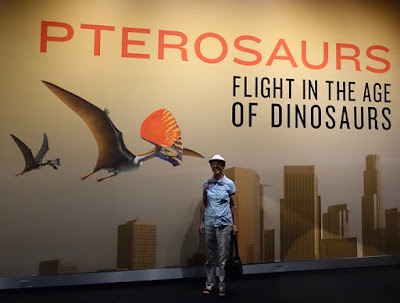 |
| Model of Pteranodon in the exhibit PTEROSAURS: Flight in the Age of Dinosaurs |
I went to see the exhibit a week ago. I was especially eager to see it because of my book Pterosaurs: Rulers of the Skies in the Dinosaur Age (out of print but now available as an e-book on Amazon.)
I learned from promoting my book that "pterosaur" is a tricky word. While most five-year-olds know about pterodactyls and have no trouble pronouncing the name, when adults see the word “pterosaur” they stumble on the silent “p”. (“Ptero” is the Greek word for “wing”.) So, if you see a “p” at the beginning of a pterosaur’s name, just ignore it.
Many of the pterosaurs in the exhibit were familiar, such as Pteranodon, with its twenty-foot wingspan, who once flew over the shallow seas of central North America and Thalassodromeus from Brazil, pictured on the cover of my book. But I also met some new species such as Jeholopterus, a relatively small insect eating pterosaur from northeastern China. Unlike many pterosaurs, it did not have a showy crest.
 |
| A young player tries to guide the pterosaur to catch a fish. |
 |
| Pterodactyl fossil from Solnhofen, Germany |
 |
| In this fossil from Solnhofen you can see the dark fibers of the wing membrane. |
 |
| A pterosaur's long wing was supported by the elongated bones of its little finger |
PTEROSAURS: Flight in the Age of Dinosaurs is a traveling exhibit organized by the American Museum of Natural History in New York.
Timed tickets are necessary to see the pterosaur exhibit at the Natural History Museum in Los Angeles. You can reserve them online at the NHMLA website. If you are a member, as I am, the tickets are free.
Note: A fun feature of the NHMLA website is the animated flight of a pterosaur over a map of Los Angeles, showing a pterosaur's-eye view of the city.
 |
| Interactive displays are a popular feature of the pterosaur exhibit |


No comments:
Post a Comment
Note: Only a member of this blog may post a comment.